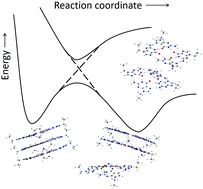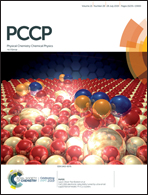The K2(9-ethylguanine)122+ quadruplex is more stable to unimolecular dissociation than the K(9-ethylguanine)8+ quadruplex in the gas phase: a BIRD, energy resolved SORI-CID, IRMPD spectroscopic, and computational study†
Abstract
A combination of experimental trapped-ion mass spectrometric studies and computational chemistry has been used in the present work to assess the intrinsic properties of the potassiated 9-ethylguanine (9eG) self-assembled quadruplex, K2(9eG)122+, in the gas phase. Infrared multiple photon dissociation (IRMPD) spectroscopy in the N–H/C–H stretching region (2700–3800 cm−1) revealed that this G-quadruplex is a sandwich-type structure with two G-tetrads sandwiching each of the two K+, very similar to the structure determined previously for the K(9eG)8+ complexes. The stability of K2(9eG)122+ toward unimolecular dissociation and its binding energy were examined using energy-resolved sustained off-resonance collision induced dissociation (SORI-CID) and blackbody infrared radiative dissociation (BIRD) kinetics experiments. SORI-CID experiments showed that the self-assembled K2(9eG)122+ complex undergoes charge separation forming K(9eG)8+ and K(9eG)4+ compared to K(9eG)8+ which loses neutral 9eG. More interestingly, K2(9eG)122+ is more stable toward unimolecular dissociation activated by SORI-CID than the K(9eG)8+ complex. Temperature dependent BIRD kinetics for K2(9eG)122+ were consistent with energy-resolved SORI-CID results showing K2(9eG)122+ to have an activation energy of 225 ± 15 kJ mol−1, approximately 50 kJ mol−1 greater than that determined for K(9eG)8+. The extra stability of K2(9eG)122+ is apparently not thermodynamic stability, but most likely due to an energy barrier for dissociation.

- This article is part of the themed collection: 2019 PCCP HOT Articles


 Please wait while we load your content...
Please wait while we load your content...